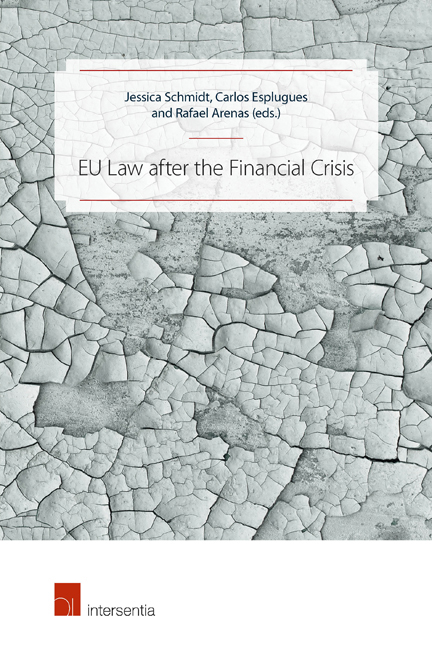Book contents
- Frontmatter
- Contents
- List of Abbreviations
- List of Authors
- Introduction
- PART I RESCUE MECHANISMS AND MONETARY POLICY
- PART II THE IMPACT OF THE FINANCIAL CRISIS ON THE BANKING SECTOR AND CAPITAL MARKETS
- PART III THE FINANCIAL CRISIS AND TAX LAW
- The European Crises as Tax Crises
- A Common Tax Policy for Europe
- PART IV THE FINANCIAL CRISIS, CONSUMERS AND CONSUMER LAW
- PART V THE FINANCIAL CRISIS AND COMPETITION LAW
- PART VI THE FINANCIAL CRISIS, RESTRUCTURING AND INSOLVENCY LAW
- PART VII THE SOCIAL DIMENSION OF THE FINANCIAL CRISIS AND EU CITIZENSHIP
- PART VIII REFLECTIONS ON THE IMPACT OF THE FINANCIAL CRISIS ON THE GENERAL EUROPEAN LEGAL FRAMEWORK AND THE FUNDAMENTAL “EUROPEAN IDEA”
The European Crises as Tax Crises
from PART III - THE FINANCIAL CRISIS AND TAX LAW
Published online by Cambridge University Press: 13 December 2017
- Frontmatter
- Contents
- List of Abbreviations
- List of Authors
- Introduction
- PART I RESCUE MECHANISMS AND MONETARY POLICY
- PART II THE IMPACT OF THE FINANCIAL CRISIS ON THE BANKING SECTOR AND CAPITAL MARKETS
- PART III THE FINANCIAL CRISIS AND TAX LAW
- The European Crises as Tax Crises
- A Common Tax Policy for Europe
- PART IV THE FINANCIAL CRISIS, CONSUMERS AND CONSUMER LAW
- PART V THE FINANCIAL CRISIS AND COMPETITION LAW
- PART VI THE FINANCIAL CRISIS, RESTRUCTURING AND INSOLVENCY LAW
- PART VII THE SOCIAL DIMENSION OF THE FINANCIAL CRISIS AND EU CITIZENSHIP
- PART VIII REFLECTIONS ON THE IMPACT OF THE FINANCIAL CRISIS ON THE GENERAL EUROPEAN LEGAL FRAMEWORK AND THE FUNDAMENTAL “EUROPEAN IDEA”
Summary
THE EUROPEAN TAX TROMPE-L'OEIL
Taxation is regularly depicted as one of the last trenches behind which national sovereigns resist the incoming European tide. This assumption is simply wrong. In fact, national tax systems have been deeply and thoroughly Europeanised since the very moment the European Communities were established. The persistent myth of the untrammelled national sovereign is largely the result of a double optical illusion. The first illusion is that of the reduction of the power to tax to the power to collect taxes. While the European Union collects very few taxes which raise very modest revenue, not only does European constitutional law (the four economic fundamental freedoms) shape (and distort) the form and structure of national tax systems and of all national taxes, but the very definition of the bases and even of the rates of many taxes (notably VAT) have been deeply Europeanised. The second is the belief that the abandonment of the original pattern of Europeanisation of national tax systems in the early 1980s meant that taxes remained a national issue. The fact of the matter is that Europeanisation of national taxes systems became deeper and faster, only it proceeded by very different means. National taxes were homogenised by the pressure exerted by economic actors making use of their revamped economic freedoms to challenge, one after the other, national tax laws that were said to create obstacles to the exercise of their economic freedoms. This shift fostered the financial, fiscal and macroeconomic weaknesses that became open crises in 2007.
GROWTH OF THE STRUCTURAL GAP BETWEEN THE LEVELS OF PUBLIC EXPENDITURE AND TAX REVENUE
Integration through the removal of tax obstacles contributed to the growth of the structural gap between the levels of public expenditure and tax revenue. At the same time, it facilitated some of the means through which the tax gap could be dissimulated (especially by turning private debt propelled activities into alternative sources of tax revenue). But while the tax gap was structural, the dissimulation strategies were bound to be both unsustainable and extremely costly (resulting from 2007 onwards in massive costs to the taxpayer).
- Type
- Chapter
- Information
- EU Law after the Financial Crisis , pp. 71 - 96Publisher: IntersentiaPrint publication year: 2016



